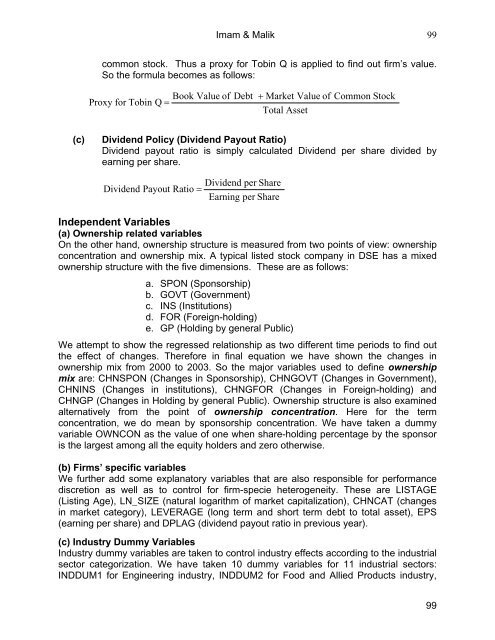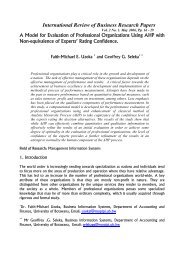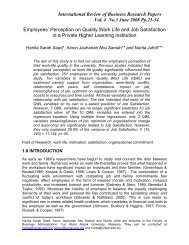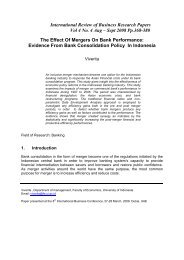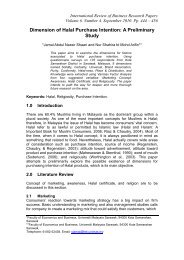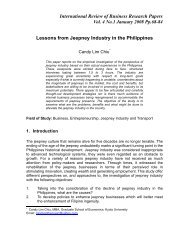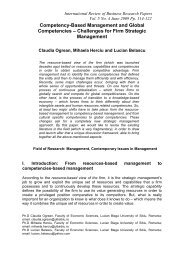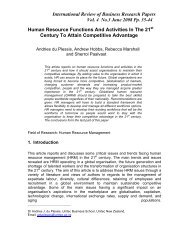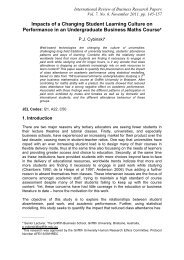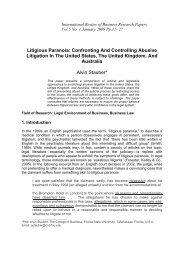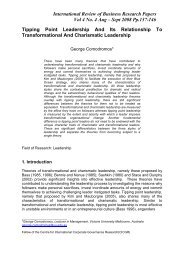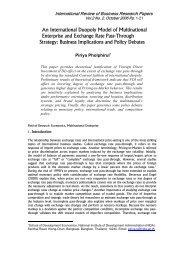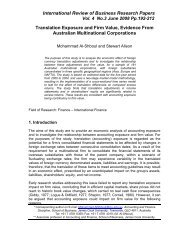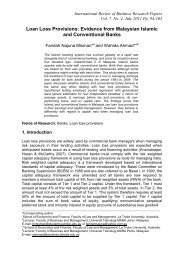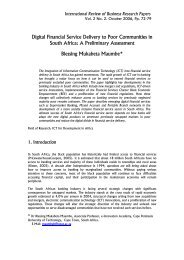Firm Performance and Corporate Governance Through Ownership ...
Firm Performance and Corporate Governance Through Ownership ...
Firm Performance and Corporate Governance Through Ownership ...
Create successful ePaper yourself
Turn your PDF publications into a flip-book with our unique Google optimized e-Paper software.
Imam & Malik 99<br />
common stock. Thus a proxy for Tobin Q is applied to find out firm’s value.<br />
So the formula becomes as follows:<br />
Book Value of<br />
Proxy for Tobin Q =<br />
Debt<br />
+ Market Value of<br />
Total Asset<br />
Common Stock<br />
(c)<br />
Dividend Policy (Dividend Payout Ratio)<br />
Dividend payout ratio is simply calculated Dividend per share divided by<br />
earning per share.<br />
Dividend per Share<br />
Dividend Payout Ratio =<br />
Earning per Share<br />
Independent Variables<br />
(a) <strong>Ownership</strong> related variables<br />
On the other h<strong>and</strong>, ownership structure is measured from two points of view: ownership<br />
concentration <strong>and</strong> ownership mix. A typical listed stock company in DSE has a mixed<br />
ownership structure with the five dimensions. These are as follows:<br />
a. SPON (Sponsorship)<br />
b. GOVT (Government)<br />
c. INS (Institutions)<br />
d. FOR (Foreign-holding)<br />
e. GP (Holding by general Public)<br />
We attempt to show the regressed relationship as two different time periods to find out<br />
the effect of changes. Therefore in final equation we have shown the changes in<br />
ownership mix from 2000 to 2003. So the major variables used to define ownership<br />
mix are: CHNSPON (Changes in Sponsorship), CHNGOVT (Changes in Government),<br />
CHNINS (Changes in institutions), CHNGFOR (Changes in Foreign-holding) <strong>and</strong><br />
CHNGP (Changes in Holding by general Public). <strong>Ownership</strong> structure is also examined<br />
alternatively from the point of ownership concentration. Here for the term<br />
concentration, we do mean by sponsorship concentration. We have taken a dummy<br />
variable OWNCON as the value of one when share-holding percentage by the sponsor<br />
is the largest among all the equity holders <strong>and</strong> zero otherwise.<br />
(b) <strong>Firm</strong>s’ specific variables<br />
We further add some explanatory variables that are also responsible for performance<br />
discretion as well as to control for firm-specie heterogeneity. These are LISTAGE<br />
(Listing Age), LN_SIZE (natural logarithm of market capitalization), CHNCAT (changes<br />
in market category), LEVERAGE (long term <strong>and</strong> short term debt to total asset), EPS<br />
(earning per share) <strong>and</strong> DPLAG (dividend payout ratio in previous year).<br />
(c) Industry Dummy Variables<br />
Industry dummy variables are taken to control industry effects according to the industrial<br />
sector categorization. We have taken 10 dummy variables for 11 industrial sectors:<br />
INDDUM1 for Engineering industry, INDDUM2 for Food <strong>and</strong> Allied Products industry,<br />
99


